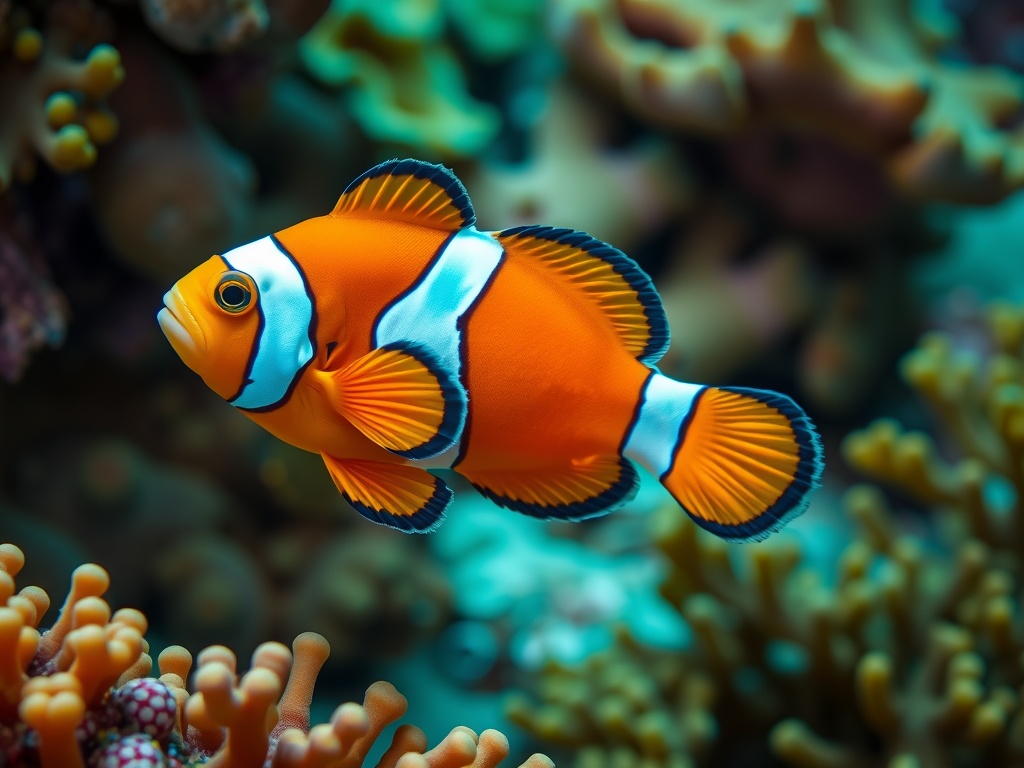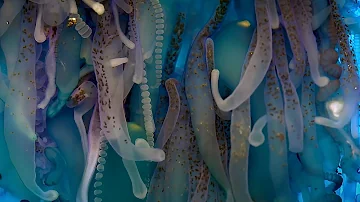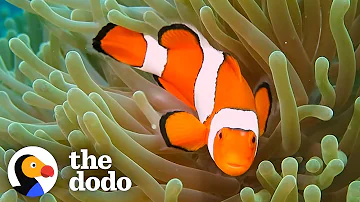
Clownfish
Amphiprioninae

Meet the Clownfish
Clownfish are small, brightly colored fish known for their vivid orange bodies, accented with white stripes and black outlining. They inhabit warm shallow seas and are most famous for their symbiotic relationship with sea anemones, which provide them protection from predators. Clownfish have a unique ability to tolerate the stings of anemones, allowing them to live among their tentacles safely. These fish exhibit fascinating social structures, including a strict dominance hierarchy with the largest female at the top.
Classification
Fish
Habitat
Coral reefs of the warm Indo-Pacific Ocean
Diet
Omnivore
Lifespan
6-10 years
Conservation
Least Concern
Weight
10-200 grams
📖Fascinating Facts
Symbiotic Partners
Clownfish and sea anemones share a mutualistic relationship: the fish are protected from predators by the anemone's stinging tentacles, while clownfish help keep the anemone clean and may provide nutrients.
Sequential Hermaphrodites
Clownfish are protandrous hermaphrodites, meaning they can change from male to female. Only the dominant male changes sex if the group's female dies.
Habitat Specialists
Clownfish are found exclusively in warm, shallow waters of the Indo-Pacific region, mainly among coral reefs where their host anemones reside.
📋Detailed Description
Clownfish (subfamily Amphiprioninae) are small, robust marine fish typically measuring 6–15 cm in length, with the largest species, such as Amphiprion percula, reaching up to 17 cm. Their bodies are laterally compressed and display striking coloration patterns, most commonly vivid orange or reddish hues with distinctive white vertical bars edged in black, although some species exhibit yellow, brown, or even black backgrounds. The skin of clownfish is covered with a thick mucus layer that contains specialized proteins, providing resistance to the stinging nematocysts of their host sea anemones. Clownfish possess a single continuous dorsal fin and rounded caudal fins, aiding in agile maneuvering among anemone tentacles. Socially, clownfish live in small groups within a single anemone, forming a strict dominance hierarchy led by a single breeding female, followed by a breeding male and several non-breeding subordinates. They are protandrous hermaphrodites, meaning all individuals are born male, with the dominant male transforming into a female if the current female dies. Clownfish are omnivorous, feeding on zooplankton, algae, and small crustaceans, as well as undigested food from their host anemones. Their mutualistic relationship with sea anemones provides both protection from predators and a reliable food source. Clownfish communicate through popping and clicking sounds, especially during social interactions and territorial disputes. Their lifespan in the wild averages 6–10 years, but can exceed 15 years in captivity.
💡 Did you know?
Every clownfish is born male, and the dominant individual in a group can transform into a female if the previous female dies.
🔬Research & Sources
Wikipedia Summary
Clownfishes or anemonefishes are saltwater fishes found in the warm and tropical waters of the Indo-Pacific. They inhabit mainly coral reefs and have a distinctive colouration typically consisting of white vertical bars on a red, orange, yellow, brown or black background. Clownfish developed a mutually beneficial relationship with sea anemones, which they rely on for shelter and protection from predators. In turn, clownfish will protect the anemone from anemone-eating fish, as well as clean and fan them, and attract beneficial microorganisms with their waste.
Last Modified: 6/12/2025
🎭Behavior & Social Structure
Clownfish exhibit diurnal activity, being most active during daylight hours when they forage for food near their host anemone. They rarely stray far from the protective tentacles, making short excursions to feed on planktonic organisms, detritus, and algae. Clownfish display complex social behaviors, including ritualized aggression and submissive posturing to maintain their hierarchical structure. The dominant female is the largest and most aggressive, while subordinate males show submissive behaviors such as body quivering. Feeding is opportunistic; clownfish will also consume parasites and debris from the anemone, helping to maintain its health. They defend their territory vigorously against intruders, using visual displays and acoustic signals. At night, clownfish seek shelter deep within the anemone’s tentacles, reducing predation risk. Juvenile clownfish undergo a pelagic larval stage, during which they disperse before settling into a suitable anemone.
👶Reproduction & Life Cycle
Clownfish are monogamous within their social group, with only the dominant female and her chosen male breeding. Spawning typically coincides with lunar cycles and warmer water temperatures, often peaking in the spring and summer. The female lays 100–1,000 adhesive eggs on a flat surface near the base of the host anemone. The male fertilizes the eggs externally and assumes primary responsibility for their care, fanning them with his fins and removing debris or infertile eggs. Incubation lasts 6–10 days, depending on water temperature. Upon hatching, larvae are planktonic and drift with ocean currents for 8–12 days before settling. If the breeding female dies, the dominant male undergoes sex reversal to become the new female, and the next largest male becomes the breeding partner. This sequential hermaphroditism ensures reproductive continuity within the group.
🛡️Adaptations & Survival
Clownfish have evolved several unique adaptations for survival. Their mucus coating contains glycoproteins that inhibit the discharge of anemone nematocysts, allowing them to live unharmed among the stinging tentacles. Behavioral acclimation, involving gradual contact with the anemone, further enhances immunity. Their bright coloration may serve as aposematic signaling, warning potential predators of their association with venomous anemones. Social hierarchy and protandrous hermaphroditism maximize reproductive success and minimize conflict within groups. Clownfish also exhibit site fidelity, rarely leaving their host anemone, which reduces predation risk and enhances survival. Their ability to communicate acoustically aids in social cohesion and territorial defense.
🎨Cultural Significance
Clownfish hold a prominent place in popular culture, most notably due to the global success of the animated film 'Finding Nemo,' which significantly increased public interest and demand for these fish in the aquarium trade. In some Indo-Pacific cultures, clownfish are considered symbols of good luck and are featured in local folklore. Their mutualistic relationship with anemones is often cited in educational materials to illustrate ecological symbiosis. There are no significant traditional uses of clownfish in medicine or cuisine due to their small size and association with venomous anemones.
🔬Recent Research & Discoveries
Recent research has focused on the molecular basis of clownfish immunity to anemone stings, revealing unique adaptations in their skin mucus. Studies on their social structure have provided insights into the evolution of sequential hermaphroditism and social hierarchies in fishes. Climate change research has highlighted the vulnerability of clownfish-anemone symbiosis to rising sea temperatures and ocean acidification. Genetic studies have clarified the phylogenetic relationships within the Amphiprioninae subfamily, leading to the identification of cryptic species. Ongoing research includes the effects of ocean noise pollution on clownfish communication and the potential for captive breeding programs to reduce pressure on wild populations.
🎥Wildlife Videos

Amazing Clownfish Teamwork | Blue Planet II | BBC Earth
#BluePlanetII Watch more: Planet Earth http://bit.ly/PlanetEarthPlaylist Blue Planet http://bit.ly/BluePlanetPlaylist Planet Earth II ...
BBC Earth

Clown Fish - My animal friends - Animals Documentary -Kids educational Videos
Step in the amazing world beneath the blue water. Mostly found in Tropical Ocean, clown fish has a striped body covered by a ...
Kids Education Online

Anemone Killer Fish Traps | World's Weirdest
#NatGeoWILD #WorldsWeirdest #Anemones About World's Weirdest: A buffalo with three eyes, an exterminator who eats his ...
Nat Geo Animals

Ocean Clown | Scuba Sam's World
Meet the clowns of the sea on this episode of “Scuba Sam's World.” Learn how clownfish live among the floating tentacles of sea ...
Nat Geo Kids

Exploring The Underwater World | 4K UHD | Blue Planet II | BBC Earth
Travel to the depths of our mysterious oceans to discover all kinds of curious creatures underwater – from fish that communicate ...
BBC Earth

The Amazing Life Cycle Of A Clownfish | The Dodo
Watch these baby clownfish hatch and grow their very first stripes! Revisit the story and check out more of Craig's work on ...
The Dodo
🌍Habitat Information
The Clownfish typically inhabits Coral reefs of the warm Indo-Pacific Ocean environments. Clownfishs have adapted to their environments with specialized features and behaviors.
Primary Habitat:
Coral reefs of the warm Indo-Pacific Ocean
More detailed habitat information will be available soon.
🛡️Conservation Status
The Clownfish is currently classified as Least Concern. Conservation efforts are crucial for preserving this species for future generations.
Common Threats:
- 🏠Habitat loss and fragmentation
- 🌡️Climate change impacts
- 🎯Hunting and poaching
- 🏭Human-wildlife conflict
⚠️Threats & Conservation Challenges
While most clownfish species are listed as Least Concern by the IUCN, they face several threats. Habitat degradation, particularly the loss of coral reefs and anemones due to climate change, ocean acidification, and destructive fishing practices, poses significant risks. Over-collection for the aquarium trade has led to localized population declines, especially in species with restricted ranges. Pollution and coastal development further threaten their habitats. Despite these challenges, many clownfish populations remain stable, thanks in part to their adaptability and the establishment of marine protected areas. Ongoing climate change and coral bleaching events, however, continue to threaten the anemone-clownfish symbiosis.
🔬Scientific Classification
Scientific Name
Amphiprioninae
Classification Hierarchy
🔍 About Taxonomic Classification
Taxonomic classification is a hierarchical system used by scientists to classify and organize living organisms based on shared characteristics and evolutionary relationships.
The system moves from broad categories (Kingdom) to increasingly specific ones, with each animal's scientific name typically consisting of its Genus and species.
📝Community Notes
Share your observations and insights about the Clownfish with our community of wildlife enthusiasts.
Join Our Community
Sign in to share your observations and connect with fellow wildlife enthusiasts.
Sign In to ContributeNo community notes yet
Be the first to share your observations about the Clownfish!
Explore Clownfish
Select a tab above to learn more about this amazing animal.
📸Photo Gallery
No photos available for this animal yet.
🌟Discover More Wildlife
Continue your journey of discovery with more fascinating animals from our database
